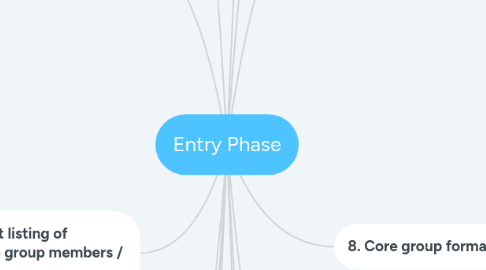
1. 1. Integration with community residents
1.1. First Hand Experience
1.1.1. Hardship
1.1.2. Aspirations
1.1.3. Hope
1.2. Immersion
1.3. Understand
1.4. Collaboration
1.5. Rapport
1.6. Trust
1.7. Methods:
1.7.1. Living with the community
1.7.2. Converse with people where they usually gather
1.7.3. Help in their household chores
1.7.4. House to house visits
1.7.5. Participate in different social activities in the community
1.7.6. Engage in economic production of the community
1.7.7. Adapt with the lifestyle of the community
1.8. HCWs connect people to:
1.8.1. To develop the poor community
1.8.2. To deeply understand the community
1.8.3. Experience a diverse aspect of culture
1.8.4. To be accepted as a member of their community
2. 3. Disseminate information / sensitization of community residents about HRDP-COPAR
2.1. sensitization of the people on the critical events in their life
2.2. motivating them to share their dreams and ideas on how to manage their concerns
2.3. mobilizing them to take collective action on these
3. 5. Long / short listing of potential core group members / leaders
3.1. Potential Leaders/Members
3.1.1. Must belong to the poor section of the society.
3.1.2. Valued group member
3.1.3. Receptive and able to fight for improvement
3.1.4. Have the initial expertise in leadership and management
3.1.5. Excellent listening ability
3.1.6. Open / willing to have a high degree of interest and desires
3.1.7. Existing desires and preferences on a mutual basis with others
3.1.8. Manifests behaviors / beliefs with honesty and reputation
3.1.9. Able to learn and develop talents
3.1.10. Committed to sharing the community's own time and energy
3.1.11. Shows a desire on a collective basis to act on something or address conflicts with others
3.1.12. Shares a vision, aspirations and beliefs close to those of individuals
4. 7. Continuation of deepening social investigation (Delos Santos)
4.1. Verification and enrichment of data collected from initial survey
4.2. For a better view how the community and its people perform in general
4.3. Results relayed through community assembly
5. 9. Definition of roles / functions of the core group
5.1. Functions of the Core Group
5.1.1. social preparation
5.1.2. organization
5.1.3. setting up and facilitation
5.1.4. sensitization and mobilization
5.1.5. participation
6. 11. Presentation of baseline survey results to the community
6.1. Data presentation will depend largely on the type of data obtained.
6.1.1. Descriptive data - narrative reports
6.1.2. Numerical data - presented in tables and graphs.
7. 13. Consult the community about the need to organize the CHO
8. 2. Conduct deepening social investigation
8.1. Community Study
8.2. To draw a clear picture of the community
8.3. Phase
8.3.1. Beginning
8.4. Process
8.4.1. Continuous
8.4.2. Never Ending
8.5. Pointers to Remember:
8.5.1. Community Leaders can be trained initially
8.5.2. Secondary Data should be examined
8.5.3. Facilitate social investigations
8.5.4. Regular confirmation and validation of data
8.5.5. Trust of people in the community
8.5.6. Avoid the use of survey questionnaire
8.5.7. Informal methods such as social gathering and house to house visits
8.5.8. Workshop and small group discussions for data gathering
8.6. Data:
8.6.1. Demographic
8.6.2. Cultural Beliefs
8.6.3. Education
8.6.4. Economic Condition
8.6.5. Morbidity and Mortality
8.6.6. Health Services
8.6.7. Organizations
8.6.8. Food Supply
9. 4. Formulate criteria for selection of core group members
9.1. Recognize the role of local authorities
9.2. With good moral and attitude towards the community
9.3. Adopt a low-key profile
10. 6. Delivery of essential services (CI / Students)
10.1. Provision of Health Services
10.1.1. Acute health problem response
10.1.2. To provide immediate interventions
10.1.3. To emphasize Preventive aspects of Healthcare
10.1.4. To draw out the people’s interest in the health programs
10.1.5. Community Integration and Organizer Enhancement
10.2. Health Problems that need Immediate Attention:
10.2.1. High prevalence:
10.2.1.1. Undernutrition
10.2.1.2. Parasitism
10.2.2. Epidemics
10.2.3. Disaster
10.2.3.1. Relief
10.2.3.2. Rehabilitation
10.2.4. Seasonal Activities: During Summer
10.2.4.1. Herbal / Medicine Hunting & Preparation
10.2.4.2. Deworming
10.2.4.3. “Operation Tuli”
11. 8. Core group formation
11.1. A group of 8- 10 individuals/comm
11.1.1. Leadership potentials
11.1.2. Cohesive Working Unit
11.2. Strategies
11.2.1. Integration
11.2.2. Deepening social investigations
11.2.3. Training and Education
11.2.4. Knowledge
11.2.5. Skills
11.2.6. Attitude
11.2.7. Awareness
11.2.8. Consciousness
11.2.9. Relationship
11.2.10. Mobilization of core group
12. 10. Conduct team building / sensitization / formal education of the core group
12.1. Purpose: To strengthen the organization and develop its capability to attend to the community’s basic health care needs.
12.2. Concepts:
12.2.1. Conduct of the community diagnosis
12.2.1.1. Profile of the local health situation
12.2.2. Training of the community health workers
12.2.2.1. Decision on roles
12.2.2.2. Training needs analysis (TNA)
12.2.3. Health services provision and mobilization
12.2.3.1. Strengthen collective spirit
12.2.3.2. Enhance confidence
12.2.4. Leadership formation activities
12.2.4.1. Meetings, assessment to evaluation
12.2.4.1.1. Organizing skills
12.2.4.2. Human relations
12.2.4.3. Supervisory skills
13. 12. Conduct self-awareness and leadership training among leaders
13.1. POTENTIAL LEADERS (main branch)
13.1.1. Future community organizers
13.1.2. Partners in health services delivery
13.1.3. Form and Lead the CHO
13.1.4. Take on managed roles
13.1.5. Characteristics:
13.1.5.1. Poor sector in community
13.1.5.2. Respected community member
13.1.5.3. Unquestionable credibility
13.1.5.4. Wide sphere of influence
13.1.5.5. Responsive
13.1.5.6. Willing to work for change
13.1.5.7. Initial leadership and management skills
13.1.5.8. Good communication skills
14. 14. Formation of the community research team
14.1. Functions of the Core Group and its Members
14.1.1. Social preparation of the community for health and development work.
14.1.2. Organization of a community research team for the conduct of community diagnosis.
14.1.3. Setting up of the Community Health Organization and facilitation of the identification of potential CHWs.
14.1.4. Sensitization and mobilization of the community to act on their more immediate health needs
14.1.5. Participation in the delivery of essential health services.
